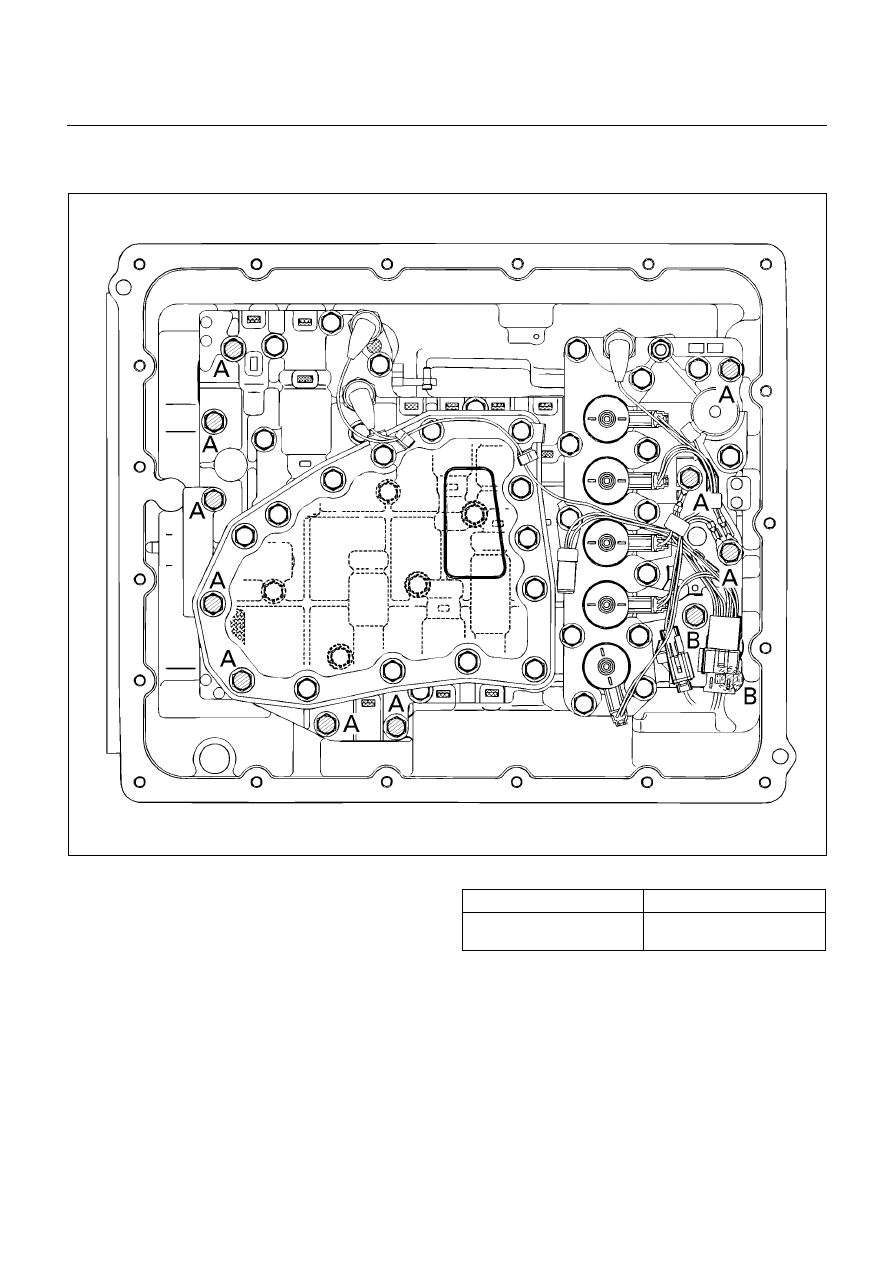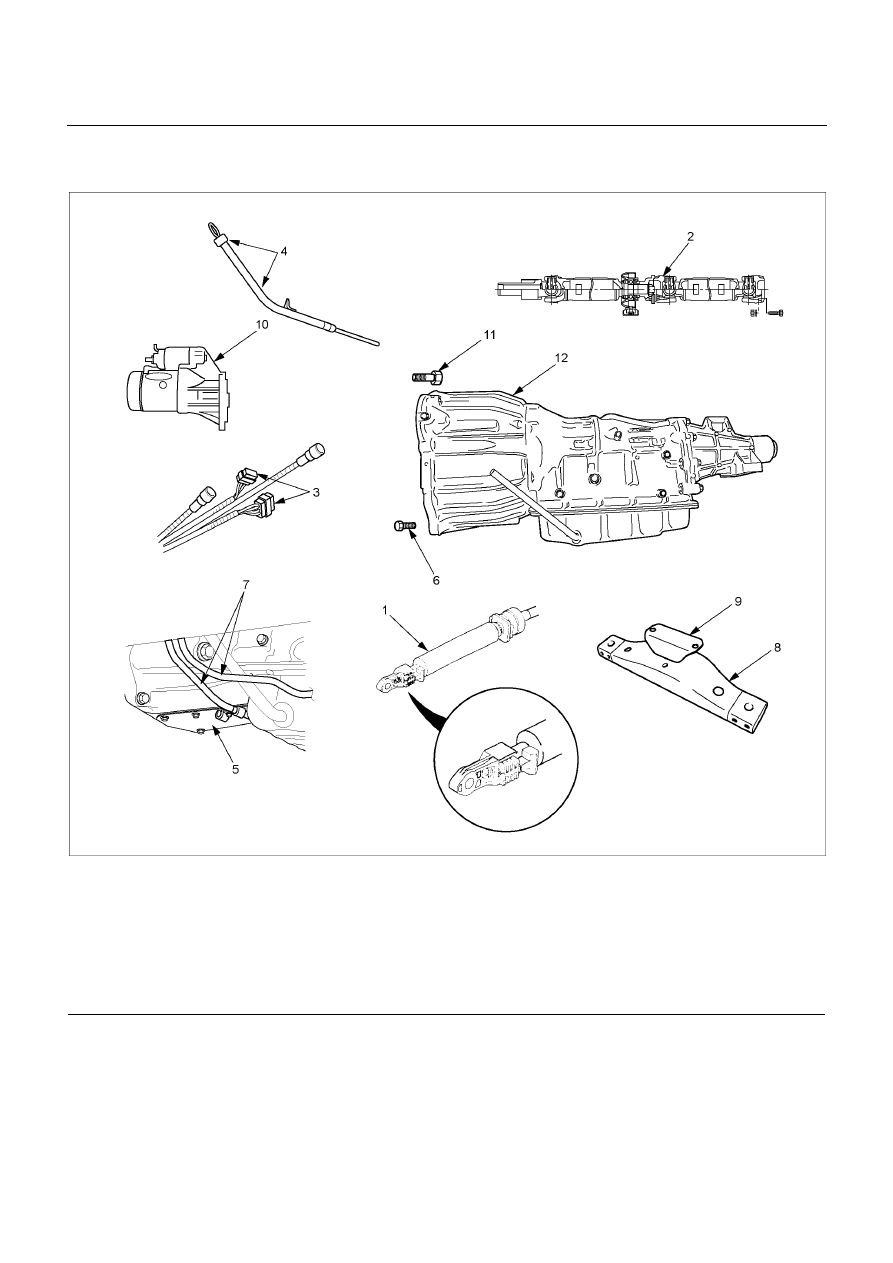Isuzu D-Max / Isuzu Rodeo (TFR/TFS). Manual — part 1782

ON-VEHICLE SERVICE (JR405E) 7A3-17
Remove or Disconnect
1. Block the wheels.
2. Disconnect the negative battery cable.
3. Drain the fluid.
Refer
to
“ATF CHANGE” in this section.
4. Remove the 19 bolts and oil pan.
5. Inspect the bottom of the oil pan and strainer netting
for foreign material (clutch facing and metal
shavings).
If there is an excessive accumulation of foreign
material, the oil strainer must be replaced.
Further inspection is required to determine the
source of the foreign material.
6.
Remove the harness assembly (including oil
temperature sensor).
7. Remove the 11 bolts and the solenoid fixing plate.
8. Remove the 6 solenoids and 3 oil pressure switchs.
Inspect
Oil pressure switch
Apply compressed air (392 kPa/4.0 kg/cm
2
) to the oil
pressure switch to check the oil pressure switch
continuity between the connector and screw.
Oil temperature sensor (harness assembly)
Check the oil temperature sensor resistance between
harness terminals 7 and 6 (ground).
Oil temperature sensor resistance:
2,400~2,600
ohms
(20
°°°°
C)
244L300011
Solenoid
Measure the resistance of each solenoid.
Resistance:
Brown connector – 3.0~3.4 ohms (20
°°°°
C)
Gray connector – 12.0~13.2 ohms (20
°°°°
C)
White connector – 12.2~13.4 ohms (20
°°°°
C)
Install or connect
1. Install the O-rings to each of the solenoids.
2. Install the 6 solenoids and 3 oil pressure switchs.
Line pressure solenoid bolt torque:
8
N·m (69 lb·in)
Oil pressure switch bolt torque:
4.4
N·m (39 lb·in)
3. Install the solenoid fixing plate together with the
harness brackets.
Number
Length
(Color)
Solenoid fixing plate bolt
(A)
(B)
4
7
16 mm (0.63 in) (Gold)
45 mm (1.77 in) (Silver)
Bolt torque : 8 N·m (69 lb·in)
4. Install the harness assembly.
5. If removed, install the oil strainer.
Number
Length
(Color)
Oil strainer bolt
(C)
(D)
9
4
13 mm (0.51 in) (Silver)
45 mm (1.77 in) (Silver)
Bolt torque : 8 N·m (69 lb·in)
6. Install the new gasket and oil pan.
Bolt torque : 8 N·m (69 lb·in)
7. Fill the fluid.
Refer
to
“ATF CHANGE” in this section.
8. Connect the negative battery cable.
9. Remove the wheel blocks.

7A3-18 ON-VEHICLE SERVICE (JR405E)
CONTROL VALVE ASSEMBLY
244L300001
Remove or Disconnect
1. Block the wheels.
2. Disconnect the negative battery cable.
3. Drain the fluid.
Refer
to
“ATF CHANGE” in this section.
4. Remove the 19 bolts and oil pan.
5. Inspect the bottom of the oil pan and strainer netting
for foreign material (clutch facing and metal
shavings).
If there is an excessive accumulation of foreign
material, the oil strainer must be replaced.
Further inspection is required to determine the
source of the foreign material.
6. Disconnect the 2 harness connectors leading to the
control valve.
7. Remove the 12 bolts and the control valve assembly.
Number of bolts
Length
10 (A)
2 (B)
40 mm (1.57 in)
30 mm (1.18 in)
Note:
Take care not to disturb the manual valve (inside the
control valve assembly).
Do not allow the pin to fall free (the pin prevents the
valve from turning).

ON-VEHICLE SERVICE (JR405E) 7A3-19
Install or Connect
1. Align the manual valve and the manual plate of the
transmission case.
43ASSY119
2. Install the control valve assembly and tighten the 12
fixing bolts to the specified torque.
Number of bolts
Length
Color
10 (A)
40 mm (1.57 in)
Gold
2 (B)
30 mm (1.18 in)
Gold
Bolt torque : 8 N·m (69 lb·in)
3. Connect the 2 harness connectors.
4. If removed, install the oil strainer.
Refer
to
“Solenoids, Oil Pressure Switch and Oil
Temperature Sensor” previously in this section.
5. Install the new gasket and oil pan.
Bolt torque : 8 N·m (69 lb·in)
6. Fill the fluid.
Refer
to
“ATF CHANGE” in this section.
7. Connect the negative battery cable.
8. Remove the wheel blocks.
FLUSHING THE TRANSMISSION FLUID COOLER AND LINE
The fluid cooler and lines may be flushed under the
following condition. This will help prevent more trouble
after the transmission is repaired.
1. When the abnormal amount of debris are found.
2. When the abnormal wear or chips on gears and
shafts are found while overhauling.
3. When the abnormal clutch facing wear and oil
contamination are found.
Procedures
1. Block the wheels.
2. Disconnect negative battery cable.
3. Raise vehicle and support with suitable safety
stands.
4. Disconnect fluid cooler lines at transmission case
and fluid cooler.
5. Flush and back-flush the fluid cooler and lines using
solvent and compressed air.
Note:
DO NOT exceed 197 kPa (29 psi) air pressure or
damage may result to oil cooler.
6. Remove all remaining solvent from the system with
compressed air.
7. Flush the cooling system again with Automatic
Transmission Fluid (ATF).
After the final flush, connect all lines.
Cooler line joint connector torque :
44
N·m (33 lb·ft)
8. Replenish ATF
9. Start engine to test the system for the free flow of
fluid. If the flow is restricted, the cooler assembly or
lines must be replaced.
Repeated cleaning and flushing may not remove all
debris from the fluid cooler circuit.
Move the select lever through the various ranges and
return to neutral.
Check for fluid level.
If the fluid level is below the specified range, ATF
must be added.
10. Connect negative battery cable.
11. Remove safety stands.
12. Remove wheel blocks.

7A3-20 ON-VEHICLE SERVICE (JR405E)
TRANSMISSION ASSEMBLY
RTW37ALF001401
Legend
1. Shift Cable
2. Propeller Shaft
3. Engine Harness
4. ATF Level Dipstick
5. Under Cover
6. Bolt
7. ATF Pipe
8. Crossmember
9. Bracket
10. Starter Motor
11. Bolt
12. Automatic Transmission
Remove or Disconnect
1. Block the wheels.
2. Disconnect the negative battery cable.
3. Raise the vehicle and support with the suitable safety
stands.

Нет комментариевНе стесняйтесь поделиться с нами вашим ценным мнением.
Текст